#Brass Plumbing Fittings
Explore tagged Tumblr posts
Text
Brass Pipe Fittings Manufacturer and Supplier in India
GK Metals is top brass pipe fittings manufacturers in India. We manufacture supply and export various types of brass pipe fittings, brass plumbing fittings, brass sanitary fittings, brass connectors, hex socket and reducer etc. that are resistant to corrosion from water, heat, acids and minerals.

#brass pipe fittings#brass pipe fittings manufacturers#brass pipe fittings supplier#brass pipe fittings manufacturers in india#brass plumbing fittings#brass plumbing fittings manufacturers#brass sanitary fittings#brass plumbing fittings suppliers#brass plumbing fittings india
0 notes
Text

Atlas Metal offer products in a variety of metals like Brass, Zinc, Stainless Steel etc. and also we make customized products exactly in accordance with the specification of the customer and keep desire to provide best quality which satisfies customer’s expectations at a competitive price.
#Brass Components#Metal Industries#Pipe Fitting Manufacturers#Brass Fittings Manufacturer#Brass Pipe Fitting#Brass Pipe Fittings#Cable Gland Installation#Brass Plumbing Fittings#Brass Manufacturer
0 notes
Text
i love looking up lyrics to oh hellos songs bc without fail every single line has an overly-detailed annotation made by someone who is either gay, (ex)catholic, or a classics major (or some combination of the above). like yes. i will absolutely read this 5 paragraph essay you wrote in the genius annotations.
#my posts#im doing office work this morning so i cant listen to a podcast and if i dont listen to something i will die. or just be on my phone.#and i cant do that bc i have. a backlog of ~200 discontinued items and their replacements to review and properly add to inventory.#most of which are brass plumbing fittings which means i have to fucking. also make new signs with the label maker after this.
3 notes
·
View notes
Text
Historical Beginnings:Brass Plumbing Fittings
The use of brass in plumbing can be traced back to ancient civilizations. Brass, an alloy of copper and zinc, was prized for its durability and resistance to corrosion, making it an ideal material for early plumbing systems. Ancient Romans were among the to use brass fittings in their complex aqueducts and water distribution systems. The alloy’s ability to withstand water pressure and resist decay ensured that these early plumbing systems could effectively deliver water to homes and public baths.
During the Middle Ages, the use of brass in plumbing became more refined. European artisans began to craft more sophisticated fittings and valves, leveraging brass’s properties to improve water control and distribution. These fittings were essential for the construction of elaborate fountains and private water systems, demonstrating the material’s continued importance in both public and private infrastructure.
0 notes
Text

Bahramdipity - Chapter One
Written for the September 2024 @jilychallenge
Prompt: exchange students are announced at the opening feast, you are assigned to show them around (perhaps there’s history between them? Summer fling or fight
Partner: @tedwardremus
My first Jily Challenge! I took some liberties with the prompt, which I think is allowed, but if not, let's just pretend I didn't know any better!
Let's also pretend that I always meant for this to be the start of a new multi-chapter WIP, and didn't spend ages trying to convince myself that I could tie it all up in a one-shot...
Bahramdipity: the suppression of a serendipitous discovery Lily Evans, Ilvermorny Potions teacher, is excited to be joining the staff of Hogwarts as part of a year long teaching exchange programme. But first, she’s going to make the most of a few days in London…
Rating: Mature
Read Chapter One on AO3
Snippet below the cut:
Lily loved her room at The Leaky Cauldron. It oozed old world charm, with its ancient dark floorboards, wooden chandelier topped with dripping candles, and total lack of any right angles anywhere. There was an ensuite bathroom with brass taps and slightly questionable plumbing, a fireplace just begging for a roaring fire (curse the fact that it was August), and a wonderfully squishy armchair.
However, the jewel in the crown was the bed. Lily had never slept in a four poster before, and it was pure bliss. It had a supremely comfortable mattress, crisp white linen, fluffy pillows and a very attractive man asleep in it.
Granted, the man wasn’t technically one of the fixtures and fittings, being a recent acquisition, but he definitely improved the general amenities of the room.
She’d met him in the pub downstairs, where she’d been having a quiet drink whilst pondering what a bored, single witch could do to fill the final evening of her short stay in London. Enter her very own, highly entertaining Prince Charming.
They’d gotten talking at the bar, and it wasn’t long before he ditched his friends to join her, waving away their pointed comments and catcalls. From that point on, he’d provided just the distraction she needed.
Now, as tendrils of morning sunlight crept across the sheets, Lily examined him carefully. He was tall (taller than Lily by several inches, and she was hardly short herself), and leanly muscular, all long lines and sinew. His sooty hair spilled messily across the snowy pillow, which she would have put down to the energetic pursuits of the night before, if it hadn’t looked exactly the same when she’d first clapped eyes on him.
Continue reading on AO3
20 notes
·
View notes
Text
Get My Heart Under Contract
Written because I couldn't shake this post by @stonelionhearts. Thanks to @velvethopewrites for the little push i needed to write it!
ao3 1400 words, rated T (for now anyhow) 4926 word, Rated E
This is all Gabriel’s fault.
Cas’s business is doing just fine. He’s staying busy. He has a steady stream of customers. Home improvement never goes out of fashion. But his brother has insisted he join a--God, Cas can hardly even think it without rolling his eyes--networking group. Which is why Cas is dressed in a goddamn dress shirt, tie, and slacks on a Tuesday morning instead of finishing up the jetted tub install on his latest job.
Which reminds him. He needs to pick up a part. Glancing at the time, he sees he has a few minutes to kill before the meeting starts. He’s across town from his usual hardware store, but these chains are all the same so he can pop into the one over here and kill two birds with one stone.
He strides purposely into the store, confident he’ll know the layout, to grab the piece and be on his way again. Instead, he finds himself wandering from aisle to aisle, frustration building as he does. By the time he finds the plumbing section, he’s muttering to himself about inefficient store planners and glaring at the long rows of products as if they've personally offended him. Honestly, if he had the time he’d start re-organizing the entire layout in a way that actually makes sense. Sighing, he tries again to find what he’s looking for, a small headache beginning behind his eyes. Definitely Gabriel’s fault.
A friendly voice comes from his left. “Can I help you?”
Cas tugs at his own collar in an attempt not to snap at this salesperson who has no idea he’s just taken his life into his own hands. He turns to crisply dismiss the poor fellow and finds himself face to face with what can only be described as an incredibly beautiful man. He’s looking at Cas expectantly, green eyes wide. There’s a smattering of freckles on his face, and he wets his lips as he waits for Cas to answer. Which Cas should definitely do, but this is such an unexpected turn of events that Cas finds they’re standing and staring at each other for much longer than is socially appropriate.
The man--and now Cas sees he’s got a name tag pinned to his work apron--Dean nods at the display and tries again. “Looks like you’re working on a plumbing project. Those can be tricky. Do you know what piece you need?”
Of course Cas knows what he needs. He’s got all the dimensions memorized. He could do this job in his sleep. “Uh,” he begins, and has to clear his throat. He holds out his hands. “About this big?”
Dean studies the display, his tongue poking out at his concentrates. It’s all Cas can do not to reach out a hand to steady himself. He’s watching Dean’s face instead of finding the part he needs, and maybe he should feel bad about all this blatant staring, but he feels something akin to starstruck by this man.
“It’s probably this one.” Dean reaches for the exact part Cas was looking for, and Cas watches the muscles of his shoulder flex beneath his tight black t-shirt. “But just to be on the safe side, you might want to take this size as well.” He turns to face Cas, a part in each hand. “We make returns as easy as possible,” he says with a smile.
Cas definitely only needs the larger size. He takes both parts, happy to have something to do with his hands at least. “Thank you. That’s very helpful.”
“Anything else?”
If Cas leaves right now, he’ll only be about five minutes late for the networking meeting. He takes a step to his left, moving into Dean’s personal space, and pivots to the display behind them. “Can you tell me about these?”
They’re nothing complicated. Ball valve shut offs. Cas has an entire drawer of them in his tool box. Still, Dean answers his question respectfully, explaining various uses and pointing out the differences. “And these?” Cas realizes he's pointed to a display of brass nipple fittings and why do all these pieces sound so dirty? Cas works on not blushing as he lets Dean’s words wash over him, watching the way Dean’s face lights up as he talks, his strong hands picking things up to show Cas the minute differences. There’s nothing condescending in his speech, just the pure joy of sharing his knowledge with someone who wants to learn.
And does Cas ever want to learn. He wants to learn if Dean’s lips are as soft as they look. He wants to learn if those gold flecks in his green eyes look different under candlelight. He wants to learn how the calloused touch of those work-worn hands would feel on Cas’s shoulder and chest and hip…
“You know a lot about building things, it seems,” Cas manages. “Where did you learn it all?”
Dean glances away. “My dad was all about uh, DIY, I guess you could say. Left me with some skills.” There’s a story there, Cas is sure. He wants to learn that, too. Dean, however, seems eager to change the subject. “What about you? Are you working your way through your honey-do list?”
Cas watches as Dean’s mouth twists, like he regrets the words as soon as they leave his mouth. It warms something inside him and he’s quick to respond. “Nothing like that. I live alone.”
Dean smiles at him. “You know, you’re going to need a piece of drywall to patch the hole after that installation.”
He’s not wrong. And Cas has many pieces available already. He feels his head tilt, eyes squinting in confusion. “Where would I find that?”
“Happy to show you!” Dean leads the way, and dear God now Cas can see that he’s got bowed legs, his hips swaying as he walks in a way that has Cas wanting to learn many, many more things.
Dean continues to guide him through the process, at some point grabbing a flat bed cart and loading it up with everything Cas might need. He opens up a register so that he can handle the payment himself. “Thank you, Mr. Novak,” he says, handing him the receipt. And then he offers to help Cas out to his car.
“Oh, that won’t be necessary,” Cas says quickly, because this has gotten out of hand. “I can do it.”
“Nonsense,” Dean says. “No point in you getting dirty when you’re all dressed up nice for work.” He reaches a hand out and Cas freezes, breath caught in his throat, but all Dean does is flip his tie which has somehow turned backwards. While Cas will his pulse to slow, Dean grips the cart. “Now, where are you parked?”
Any other protests die on his lips. There’s nothing to be done and Cas leads him across the parking lot, doing a walk of shame to his very own contractor van parked at the end of a row.
Dean pulls up short with the cart, eyes blinking rapidly. “Novak,” he says. “That’s you?”
“I’m so sorry,” Cas says in a rush, knowing that he’s ruined this. “I didn’t mean to mislead you, it’s just that…”
Dean raises an eyebrow. “Just that what?”
Cas can’t look at him. He stares miserably at his stupid dress shoes. “I was enjoying your company so much.”
There’s a long pause. “Hmm.” Chancing a look, Cas sees Dean is smiling at him. It’s a bit smug, but it looks good on him nonetheless. Dean pulls out his phone and takes a picture of the side of the van. “So, I could call you if I want to continue this conversation?”
Relief has Cas smiling back. “I wish you would.”
Together they unload the cart. “So, what’s with the monkey suit?” Dean asks.
“My brother convinced me to go to a business networking meeting.” Cas checks his watch. “Which I am now embarrassingly late for.”
Dean leans a hip against the side of the van. “That so? Guess you’ll never meet anybody new then.”
“Guess not.” They’re staring at each other again.
Finally, Dean breaks eye contact. “I gotta get back.” He reaches out a hand. “It was a pleasure helping you today, Mr. Novak.”
Cas clasps his hand longer than necessary. It’s warm and strong and Dean uses his thumb to rub a small, secret circle on Cas’s skin. “Call me,” Cas says and it only sounds a little desperate.
“Oh, I will,” Dean assures him with a wink. “You look like the answer to all my pipe-laying needs.”
164 notes
·
View notes
Text
Learning to Smelt - 1
I've been wanting to talk about this for a while. Last year, I wanted to pick up smelting. It seemed fun, and felt right up my field in the realm of making things. I did all the research, got the equipment and earlier this year I finally managed to start! My goal is, once I'm comfortable enough to do it solo (since I had help from my insane uncle during my training adventure) to have it livestreamed and smelt things on request! Honestly at this point I reckon my skills have advanced to the point of almost competence (huzzah!) Nonetheless I want to post some stuff showing the process, just in case anyone's curious!
First off, I made an AGGREGIOUS error when it came to choosing the smelter brand. The one I bought didn't have a connector that worked with Australian Gas tanks, only US ones. I was very luck my uncle had a bunch of spare fittings/hoses lying around otherwise it would've been impossible to do anything from the start. Funnily enough too, despite it eventually getting to +1000 C temperatures, it didn't need that much fuel overall! Only had to slightly open the valves with one full rotation on the gas tank. I guess that's by design, since the whole idea is keep heat in (this just in, local hoplite PNGTuber discovers how heat works!) Also, fun fact! Don't buy a shitty $50 temperature gun that says it can get to 1000+ C and expect it to do so! So many infrared sensors are so pricey and there was no way in tartarus that I would use that kinda money on a glorified nerf gun but then it turns out the cheap one I got was incapable of reading anything beyond 400 C. Fortunately you can just eyeball it when it comes to smelting using this simple rule! If metal = solid: Wait If metal = liquid: Congratulations, you've done it!
Have to make sure it's done in a well-ventilated area too. Doubly so if you're melting brass since that garbage can burn and make zinc oxide which is NOT GOOD. First time I melted stuff was just done to make sure I knew what I was doing, not to cast anything. All I did was melt down brass and copper separately to make small ingots.

(btw if you ever plan to make casted finery, don't bother with a specific ingot mold, those things are pricey. Just get a cast iron muffin tray w/o the teflon on it or something similar. You can make a lot more that way and they're more likely to fit in the crucible if you want to re-melt). Also another piece of advice: DON'T OVERLOAD THE CRUCIBLE. My uncle wanted us to melt down all the copper we had (which was a lot, I had been going to town on the neighbourhoods wiring/plumbing in preparation for this) since "it was more energy efficient to smelt more instead of letting it cool down!" While technically true, a crucible full of copper is VERY HEAVY and picking that thing up with crucible tongs is gonna be a legendary struggle. We did end up spilling a bit, fortunately it didn't go anywhere. The vid attached to this post shows it: A crucible full of copper and regret for our lack of forethought. Following day I did try to cast one thing: My channel emblem as a medallion. I poured molten copper into an open sand mold and well, you be the judge:
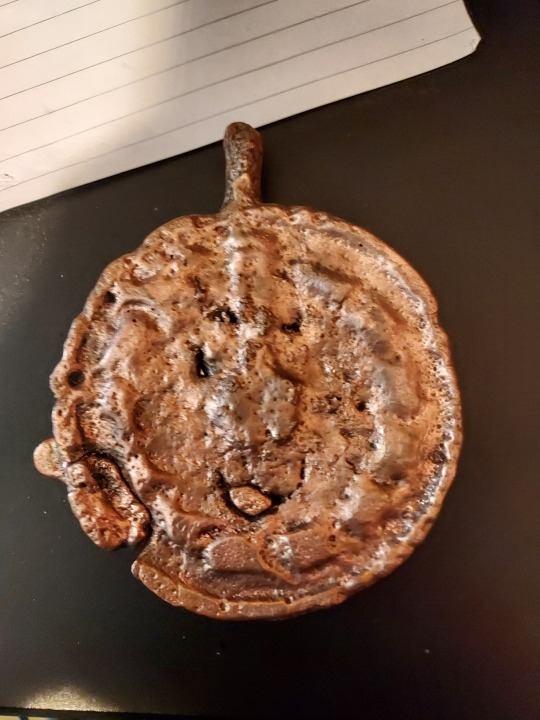
Still, twas a good first go! Thanks to the ingot molder we used the cast metal in it's default form comes out in a style akin to that of a paperweight.
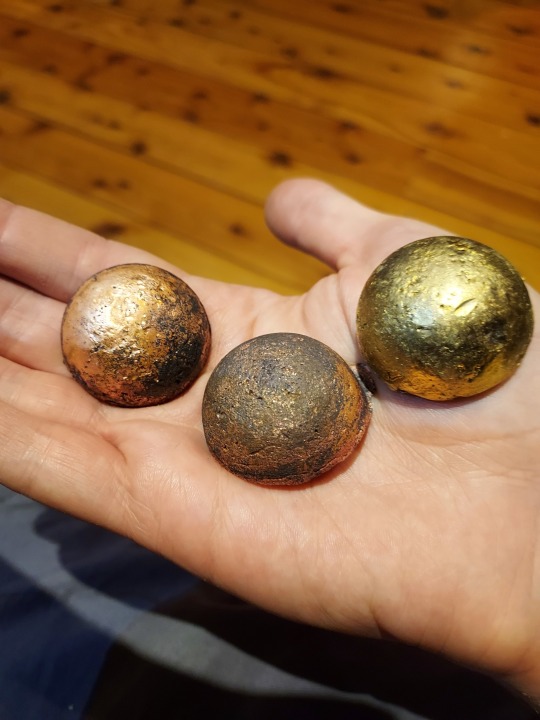
I'll be posting details on the second and third smelt soon, so stay tuned!
6 notes
·
View notes
Text
DIY Sculptural Copper Coil Vases

Project by Kate Pruitt:
Grace, Amy and I have been experimenting with all kinds of copper, brass and aluminum products lately, and we all agree: soft, malleable metals are delightful. They won’t always bend precisely or do exactly what you want, but that’s part of their charm. So if you find this project a bit frustrating at first, the key is to let go and allow the coil to do what it will. In the end, you’ll wind up with something far more organically beautiful than anything I could draw a template for, and much more fun!— Kate
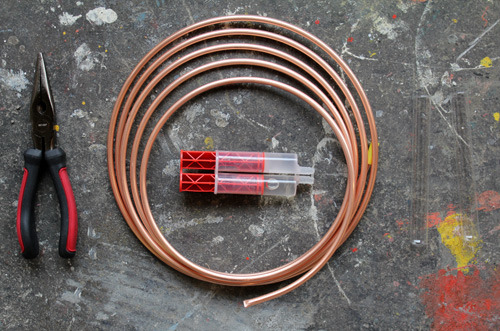
Materials
1/4″ x 20′ copper coil (you can find this in the plumbing section of hardware stores)
needle nose pliers
glass test tubes or some other cylindrical glass vessels
quick set epoxy
painter’s tape (optional)
Instructions
1. Cut a 24″ length of wire from the coil with your pliers. If your pliers don’t go all the way through the coil, you can just pinch the wire with the pliers, then push the coil back and forth on the pinched seam; this should cause the coil to break easily.

2. Begin bending your coil into a shape. There is no wrong way to do this. The coil bends very easily in your hands. Periodically place the shape down on a surface to see if it’s balancing, and if not, simply bend parts until it does. It doesn’t really matter what the bottom end does, but one end of the coil should be up high so that you can bend it to hold the vase.
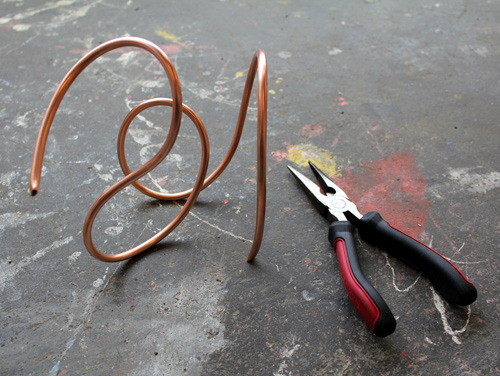
3. Once you have your basic shape, use your pliers to pinch and bend the top end of the coil into a tighter circle. The coil won’t become a perfect circle — it will be more of an elliptical shape, but it needs to be small enough to slide your glass tube inside for a snug fit. Again, the coil won’t perfectly surround the shape of the tube, but as long as the elliptical shape pinches the mouth of the tube to hold it in place, and some part of the copper touches the tube on both sides, you’re fine.
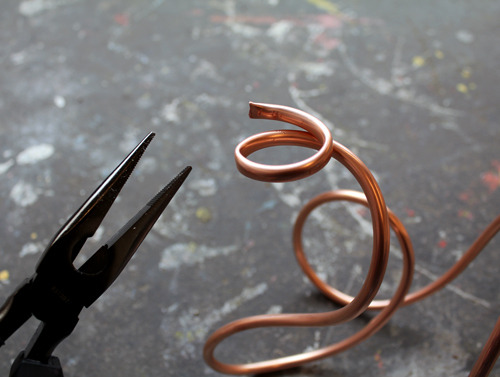
4. Slide the glass tube into the copper ring you made to check the shape. If it’s too tight, loosen the ring a bit; if it’s too loose, pinch it shut a little. The tube should be able to slide in and out gingerly, and the sides of the tube should touch the copper coil ring at two points around its circumference.
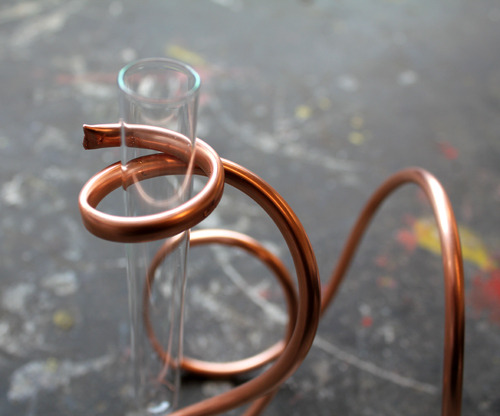
5. Remove the tube again and mix up a small batch of epoxy (follow the epoxy’s instructions for mixing) onto a jar lid or paper plate. You can use a popsicle stick, pencil or small paintbrush to mix and apply epoxy. Place a small ring of epoxy around the spot where you want the tube to hit the coil ring. I varied the height of my tubes: the shortest sticks up 1″ above the copper ring, and the longest sticks up 3″ above.

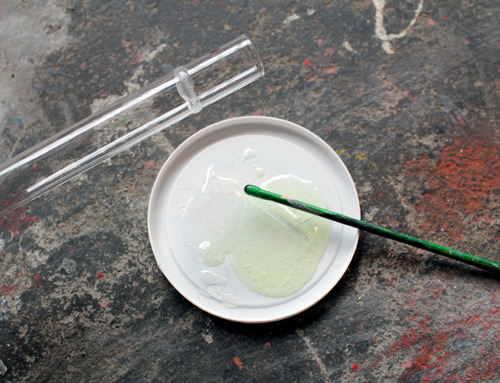
6. Slide the tube back into the copper ring until the epoxy hits the inside of the copper ring, then stop. Straighten the tube so it’s perfectly vertical, and put it aside for the epoxy to set. If your vase wants to slide out or wiggle during this process, you can use a piece of painter’s tape to hold the vase in place while the epoxy sets.

7. Once the epoxy has set, you can remove the tape. You can clean off any excess epoxy by scraping it gently with a utility knife or paint-scraping blade. You can also make final adjustments to the copper shape if desired.
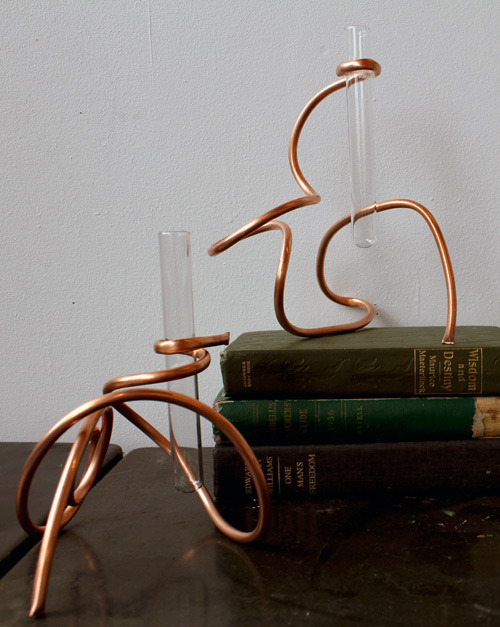
Done!
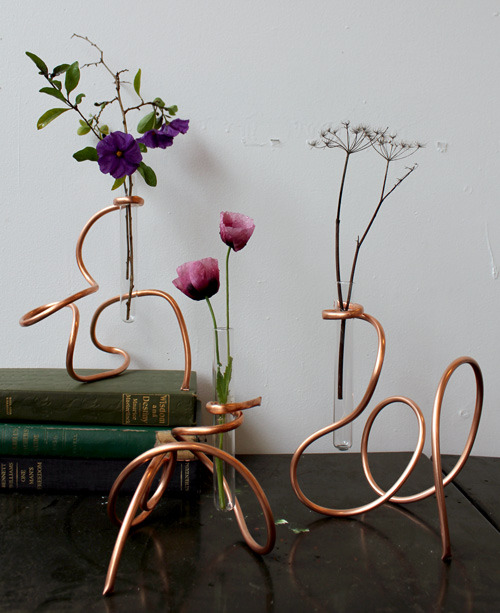
4 notes
·
View notes
Text
The Craftsmanship behind Fittings Manufacturing
Fittings like plastic fittings China are connectors that connect pipes, tubes, or hoses. They are intended to form a secure and leak-proof connection, allowing for the uninterrupted passage of liquids, gasses, or even solid objects. Plumbing, HVAC systems, hydraulic and pneumatic machinery, oil and gas pipelines, and other applications all employ fittings. These little components are the unsung heroes of numerous sectors, keeping together contemporary society's complicated architecture.

Fittings: An Art Form Manufacturing
Manufacturing fittings is a complex procedure that necessitates accuracy and attention to detail. Here's a rundown of the stages required in making fittings:
Material Selection: The selection of materials is critical in the manufacture of fittings. diverse materials, such as brass, stainless steel, PVC, or copper, are required for diverse uses. The material used must be corrosion-resistant, long-lasting, and suitable for the contents transported.
Engineers design fittings with accuracy, taking into account parameters such as pressure ratings, temperature, and flow needs. To generate precise and trustworthy products, the design process may use computer-aided design (CAD).
Machining: Machining procedures like as turning, milling, and drilling are commonly used to make fittings from metal fittings manufacturer. These operations shape and refine the material into the correct shape, guaranteeing that the fitting will work properly.
Quality Control: Throughout the production process, stringent quality control methods are employed. Inspections, testing, and monitoring are performed to ensure that the fittings fulfill industry standards and requirements.
Surface Finish: Depending on the application, fittings may be polished, plated, or coated to improve their durability and appearance.
Manufacturing Fittings Innovations
In recent years, the field of fittings production has undergone considerable developments. These advancements seek to boost efficiency, decrease environmental impact, and increase product performance. Among the significant advancements are:
3D Printing: Additive manufacturing, including 3D printing, is becoming more popular for producing complicated, bespoke fits with minimal material waste.
Sustainable Materials: To lessen its environmental imprint, the industry is investigating eco-friendly materials and manufacturing procedures.
Rapid prototype: Computer-aided design and rapid prototype techniques enable the creation and testing of novel fitting designs to be completed more quickly.

IoT technology is being integrated into fittings from plastic fittings manufacturers to monitor and optimize fluid flow, identify leaks, and increase system performance.
Follow our Facebook and Twitter for more information about our product.
#Metal fittings manufacturer#Metal fittings manufacturer China#Professional Metal Manufacturer#Metal Manufacturer China
2 notes
·
View notes
Text
Top Tips for Choosing the Best Plumbing Suppliers in Melbourne
Why Quality Plumbing Supplies Are Essential
When dealing with plumbing, quality matters. Poor-quality plumbing materials can lead to leaks, corrosion, and costly water damage. To avoid such issues, it’s crucial to select a reputable plumbing supplier in Melbourne. Whether you’re a professional plumber, contractor, or DIY homeowner, finding the right supplier ensures that your materials are durable, reliable, and compliant with standards.

What to Look for in a Melbourne Plumbing Supplier
Choosing a reliable plumbing supplier involves more than simply selecting the closest store or the cheapest options. Here are the essential criteria for selecting a trustworthy supplier:
Extensive Product Range: A good plumbing supplier will offer a variety of products, including pipes, fittings, fixtures, valves, tools, and other essential accessories. This range ensures that you can find everything you need in one place, which is especially convenient when working on large projects.
Product Quality and Warranty: The best suppliers offer high-quality materials that meet or exceed Australian standards. Many reputable suppliers offer warranties on certain items, like fixtures and fittings, as an added assurance of quality. Pipes, faucets, and valves made from high-grade materials such as brass, stainless steel, and PVC should be easily accessible.
Knowledgeable Staff: Expert staff members can be invaluable when making purchasing decisions, especially if you need guidance on materials or tools for specific plumbing projects. Suppliers with knowledgeable personnel can provide technical advice, helping you choose products suited for your needs, whether it’s residential or commercial plumbing.
Pricing Transparency: While high-quality plumbing supplies may not always be the cheapest, it’s essential that the supplier provides transparent and competitive pricing. Compare prices across several suppliers in Melbourne to find good value without sacrificing quality.
Convenient Delivery Options: A reliable supplier will have options for same-day or next-day delivery, ensuring that you get the supplies when needed. Quick delivery is particularly useful for larger plumbing projects, where the timely arrival of materials can prevent delays.
Essential Plumbing Supplies to Look for in Melbourne
Pipes and fittings: A good supplier should offer a wide selection of pipes and fittings, including copper, PVC, and PEX. Copper pipes are known for their durability, while PEX offers flexibility and ease of installation. PVC pipes are also widely used in plumbing for their affordability and resistance to corrosion.
Fixtures and faucets: Quality fixtures and faucets add both functionality and style to any bathroom or kitchen. Look for suppliers who offer products made from durable materials like stainless steel and chrome.
Valves and Controls: Valves play a crucial role in controlling water flow, temperature, and pressure. Make sure your supplier provides corrosion-resistant valves that can withstand various water systems.
Specialised Tools and Accessories: Whether for installation or repair, having access to professional-grade tools like wrenches, pipe cutters, and augers is essential. Many suppliers provide both tools for purchase and rental, catering to both professional plumbers and DIY enthusiasts.
Choosing a Supplier for Commercial Plumbing Projects
For larger, commercial projects, you need a supplier who can handle bulk orders without compromising on quality or timeliness. Look for suppliers in Melbourne with robust distribution networks to handle high-volume requirements and provide materials that meet commercial building codes.
The Benefits of Working with a Reliable Supplier
Selecting the right plumbing supplier can positively impact your project in multiple ways. By ensuring that your supplier provides quality materials, you reduce the risk of product failure, which can save both time and money in the long run. In addition, professional suppliers often offer bulk purchasing options, which can be more cost-effective for commercial plumbing projects.
Conclusion:
Finding a reliable plumbing supplier Melbourne is essential for successful, long-lasting installations. From high-quality materials to knowledgeable customer support, the right supplier ensures your projects are built on a solid foundation. Take the time to evaluate potential suppliers based on product range, quality, expertise, and delivery options to guarantee that you have everything you need for your next plumbing project.
Source From : Top Tips for Choosing the Best Plumbing Suppliers in Melbourne
0 notes
Text
The Essential Guide to Scrap Metal Recycling in Adelaide
Scrap metal recycling is an increasingly important practice in Adelaide, driven by the need for sustainable waste management and environmental conservation. As a city that values both innovation and sustainability, Adelaide offers various opportunities for residents and businesses to participate in scrap metal recycling. Here’s everything you need to know about the benefits, processes, and places to recycle scrap metal in Adelaide.
1. Why Scrap Metal Recycling Matters
Scrap metal recycling plays a vital role in reducing waste and conserving natural resources. By recycling metals like steel, aluminum, copper, and brass, we can significantly decrease the demand for raw materials, which in turn helps to lower greenhouse gas emissions associated with mining and processing. In addition, recycling metals uses up to 95% less energy than producing new metals, making it an environmentally friendly option.
2. Types of Scrap Metals You Can Recycle
Understanding the different types of scrap metals can help you sort your materials more effectively:
Ferrous Metals: These contain iron and are magnetic, including steel and cast iron. Ferrous metals are commonly found in appliances, construction materials, and automotive parts.
Non-Ferrous Metals: These do not contain iron and are not magnetic. Common examples include aluminum (found in cans and foil), copper (from wiring and plumbing), and brass (often used in fittings and fixtures). Non-ferrous metals are generally more valuable due to their higher demand and recycling rates.
3. The Scrap Metal Recycling Process
The recycling process for scrap metal involves several key steps:
Collection: Gather your scrap metal from various sources, such as old appliances, cars, or construction sites.
Sorting: Separate ferrous and non-ferrous metals, as well as different types of metals within those categories. Proper sorting ensures you receive the best price at recycling centers.
Cleaning: Remove any non-metal components, such as plastic or wood, from your scrap metal. Clean metals can command higher prices and are easier to recycle.
Transporting: Take your sorted and cleaned scrap metal to a local recycling facility. Many scrap metal recyclers in Adelaide offer collection services for larger quantities.
Processing: At the recycling facility, metals are processed, melted down, and reformed into new products, completing the recycling loop.
4. Where to Recycle Scrap Metal in Adelaide
Several recycling centers in Adelaide accept scrap metal, offering competitive prices and convenient services. Some well-known facilities include:
SA Metal Group: One of the largest and most reputable scrap metal recyclers in South Australia, offering services for both individuals and businesses.
Metalforce: This company specializes in non-ferrous metal recycling and offers collection services for large quantities.
Adelaide Metal Recycling: Located in the heart of the city, this facility provides easy access for residents to drop off their scrap metal.
Woods Metal Recycling: A family-owned business that has been operating for decades, focusing on customer service and sustainability.
5. The Benefits of Recycling Scrap Metal
Engaging in scrap metal recycling brings numerous benefits:
Environmental Conservation: Reducing landfill waste and conserving natural resources helps protect ecosystems and reduce pollution.
Economic Value: Recycling scrap metal can generate extra income, especially for businesses in construction or manufacturing sectors.
Community Involvement: Participating in recycling initiatives fosters a sense of community responsibility and encourages others to adopt sustainable practices.
Job Creation: The recycling industry contributes to job creation in areas such as collection, processing, and manufacturing.
6. How to Get Started with Scrap Metal Recycling
Getting started with scrap metal recycling in Adelaide is simple:
Educate Yourself: Learn about the different types of metals and their recycling processes.
Collect Scrap Metal: Gather scrap metal from around your home, work, or community.
Sort and Clean: Separate and clean your metals to maximize their value.
Find a Local Recycler: Research local recycling facilities and choose one that meets your needs.
Stay Informed: Keep up with changes in recycling regulations and market prices to make informed decisions about your scrap metal.
Conclusion
Scrap metal recycling in Adelaide is an essential practice that benefits the environment, the economy, and the community. By understanding the importance of recycling and the steps involved, residents can actively participate in promoting sustainability and reducing waste.
0 notes
Text
8 Tips for Choosing the Best Plumbing Fixtures for Your Bathroom
Selecting the right plumbing fixtures is a fundamental part of designing a bathroom that is both stylish and functional. With an array of options available, from elegant faucets to modern showerheads, the choices can be overwhelming. These fixtures play a vital role in the overall aesthetic and efficiency of your space, impacting everything from water flow to maintenance.
Whether you're undertaking a full renovation or simply updating a few elements, understanding how to choose the best plumber Brisbane North fixtures can enhance your bathroom experience while reflecting your personal style. In this article, we will explore 8 essential tips to guide you in making informed decisions for your bathroom plumbing fixtures.
1. Consider Your Bathroom’s Style
Before choosing any fixtures, take a moment to reflect on the overall design aesthetic of your bathroom. Are you leaning towards a modern, sleek look, or do you prefer a more traditional, vintage vibe? The plumbing fixtures you select should harmonise with your design theme to create a cohesive space.
For modern bathrooms, consider fixtures with clean lines and minimalist designs. Options like wall-mounted faucets or sleek, single-handle taps can enhance the contemporary feel. In contrast, for classic or rustic bathrooms, fixtures in finishes like oil-rubbed bronze or antique brass can add warmth and character.
2. Choose Durable Materials
Bathrooms experience high levels of moisture and usage, making it crucial to select plumbing fixtures made from durable materials. High-quality fixtures can withstand daily wear and tear while maintaining their appearance over time.
Brass, stainless steel, and solid brass are excellent choices for faucets and showerheads due to their durability and resistance to corrosion. Ceramic is commonly used for sinks and toilets, offering a classic look and easy maintenance. Avoid plastic fixtures, as they tend to wear out quickly and may not hold up against the moisture and humidity prevalent in bathrooms.
3. Water Efficiency Matters
In today's environmentally conscious world, selecting water-efficient fixtures is more important than ever. Not only do these fixtures help conserve water, but they can also significantly reduce your utility bills over time.
Look for fixtures that are WaterSense certified. This certification indicates that the fixture meets strict efficiency guidelines set by the Environmental Protection Agency (EPA). Low-flow showerheads, faucets, and toilets can save a substantial amount of water without compromising performance. For instance, low-flow showerheads can reduce water usage by up to 40% while still providing a satisfying shower experience.
4. Focus on Functionality
While aesthetics are important, the functionality of your plumbing fixtures is equally crucial. A fixture that looks great but doesn’t perform well can lead to frustration and inconvenience.
Think about the specific needs of your bathroom. For example, consider the layout of your sink: is it a single or double basin? Would a single-handle faucet be more practical than a two-handle version? Additionally, assess your shower setup. Thermostatic shower valves can ensure consistent water temperature, while handheld showerheads offer versatility and convenience, especially for families or those with mobility issues.
5. Match Fixtures to Your Plumbing
Before making any purchase, it’s essential to consult with your plumber to ensure that your chosen fixtures will be compatible with your existing plumbing system. This step can save you from potential headaches down the line.
Different plumbing setups require specific fixture types, so be aware of your plumbing’s size, configuration, and any existing limitations. For instance, if you have an older home with outdated plumbing, certain modern fixtures may not fit correctly without additional modifications. A professional plumber can help assess your situation and guide you in selecting compatible fixtures.
6. Don’t Forget Maintenance
Some plumbing fixtures require more upkeep than others, which is an important consideration when making your selections. Regular maintenance is key to prolonging the life of your fixtures and ensuring they remain functional and attractive.
For example, chrome fixtures can easily show water spots and fingerprints, making them more challenging to keep clean. In contrast, brushed or matte finishes tend to hide marks better, reducing the frequency of cleaning. Additionally, consider how easy it is to replace or repair specific fixtures. For instance, cartridge faucets often have replaceable parts, making maintenance simpler than other styles that may require complete replacement if something goes wrong.
7. Stick to a Budget
Plumbing fixtures come in a wide range of prices, and setting a budget for your bathroom renovation is essential. While it’s tempting to splurge on high-end designer fixtures, many affordable options offer both style and quality.
Consider creating a list of must-haves versus nice-to-haves. This list can help you prioritise where to invest and where to save. Keep in mind that it’s not just the cost of the fixtures themselves; you should also factor in installation costs. Hiring a professional plumber to install complex fixtures may save you from potential future issues, so budget accordingly.
8. Test Before You Buy
Whenever possible, take the time to test plumbing fixtures before making a purchase. Visiting showrooms allows you to see and feel the fixtures in person, providing a better sense of how they will fit into your bathroom.
Pay attention to the height and reach of faucets and showerheads, as well as the ease of use. Testing the flow and pressure can also give you insight into how the fixture will perform in your home. Additionally, consider the warranties and return policies offered by manufacturers. A solid warranty can provide peace of mind and protection against manufacturing defects.
Selecting the ideal plumbing fixtures for your bathroom is a blend of art and science. It requires careful consideration of style, durability, functionality, and efficiency. By taking the time to evaluate your options and keeping these 8 tips in mind, you can make choices that will not only enhance the beauty of your bathroom but also ensure its long-term performance and comfort. Remember, the right fixtures can elevate your space, providing both practical solutions and a touch of luxury that turns your bathroom into a personal sanctuary. Embrace the process, and enjoy transforming your bathroom into a stunning and functional retreat.
0 notes
Text
Brass Scrap Recycling in Lonsdale: A Sustainable Solution for Waste Management
The process of recycling metals like brass has become increasingly popular due to its environmental and economic benefits. In Lonsdale, brass scrap recycling plays a vital role in reducing waste, conserving resources, and supporting sustainable manufacturing. Whether you’re a business with brass offcuts or an individual looking to recycle old fixtures, the brass recycling industry in Lonsdale offers efficient ways to dispose of unwanted brass materials while contributing to a greener future.
What is Brass and Why Recycle It?
Brass is an alloy primarily made from copper and zinc, known for its durability, malleability, and resistance to corrosion. It’s used extensively in industries such as construction, automotive, plumbing, and electronics, where components like fittings, radiators, and valves benefit from brass’s strength and heat-resistant properties.
Recycling brass is not only cost-effective but also environmentally friendly, as it requires less energy to process than producing new brass from raw materials. In Lonsdale, recycling facilities make it easy to responsibly dispose of brass scraps, which can then be repurposed in manufacturing, reducing the need for virgin materials.
Benefits of Brass Recycling in Lonsdale
Environmental Conservation Brass recycling helps preserve natural resources by reducing the demand for new copper and zinc mining. This conservation reduces greenhouse gas emissions and the ecological impact associated with mining and processing new metal.
Energy and Cost Savings Recycling brass is significantly less energy-intensive than manufacturing it from raw materials. This translates to lower operational costs, enabling recycling facilities to offer competitive rates to those bringing in scrap.
Economic Opportunities Lonsdale’s recycling facilities provide fair compensation for brass scraps, creating an additional revenue stream for businesses and individuals. It also supports the local economy by creating jobs within the recycling industry.
Waste Reduction Brass scrap recycling prevents usable metals from ending up in landfills, where they would take up space and potentially harm the environment. Through recycling, we ensure that metal waste is repurposed effectively and sustainably.
0 notes
Text
How to Choose the Right Bathroom Fixtures at Stores in Toronto
Choosing bathroom fixtures may seem like a small part of your renovation, but they have the power to transform your space. The right fixtures combine function and form, creating an aesthetic that reflects your style while serving your daily needs.
In a city like Toronto, where countless bathroom fixture stores offer a wide range of options, it’s important to know how to narrow down your choices. In this article, we'll walk you through everything you need to consider when selecting them.
Let’s get started.

What to Consider When Buying Bathroom Fixtures at Toronto Stores
Bathroom fixtures are the unsung heroes of your home’s design. They not only affect how your bathroom looks but also how it functions. Here are some things to consider when choosing bathroom fixtures at stores in Toronto.
Understanding Different Types of Fixtures
There are several key types of bathroom fixtures you’ll need to consider. These include:
Shower fixtures: Heads, mixers, and handheld options
Bathtub fixtures: Freestanding tubs, built-ins, and more
Sink fixtures: From vanity sinks to wall-mounted options
Toilet fixtures: High-efficiency, wall-mounted, and more
Each type of fixture has its own set of considerations, and understanding them is the first step to making a smart choice.
Key Considerations for Shower Fixtures in Toronto
When it comes to shower fixtures, there are many options available at shower fixture stores in Toronto. You'll need to consider both their form and function:
Showerheads: Rainfall, handheld, or massaging?
Water pressure: Do you need a fixture that boosts or adjusts pressure?
Style: Match the finish to the rest of your bathroom (chrome, brushed nickel, et cetera).
Bathtub Options: What to Look for at Bathtub Stores in Toronto
Your bathtub is the centrepiece of your bathroom, and there are many options at bathtub stores in Toronto. Consider these factors when shopping for one:
Size: Measure your space to determine if a standard, large, or corner tub fits best.
Material: Acrylic, fibreglass, and cast iron are common materials, each with different durability and maintenance needs.
Style: Freestanding tubs offer a luxurious feel, while built-in ones save space.
Don’t forget to account for any special features you want, like jets or ergonomic shapes for added comfort.
Sink and Faucet Fixtures: Choosing the Right Design
Your sink and faucet need to balance practicality with style.
Sink type: Pedestal, undermount, or vessel sinks are popular options.
Faucet type: Single handle, double handle, or touchless faucets each offer different user experiences.
Material and finish: Choose a durable material that complements your bathroom decor (stainless steel, brushed nickel, bronze, et cetera).
Budgeting: Balancing Quality and Cost
While it’s tempting to choose the most affordable option, remember that you often get what you pay for. Fixtures from well-known brands might cost more upfront but offer better longevity and warranties. Balance your budget by prioritizing fixtures you’ll use most, like showerheads and faucets, over less-used ones, like towel racks.
FAQ
1. What are the most popular materials for bathroom fixtures?
The most popular materials include chrome, brushed nickel, stainless steel, and brass. Each offers different advantages in terms of durability and appearance.
2. How can I save water with my bathroom fixtures?
Look for low-flow fixtures, energy-efficient showerheads and dual-flush toilets to conserve water without sacrificing performance.
3. Are luxury bathroom fixtures worth the extra cost?
Luxury fixtures often provide better durability and aesthetics. While they may cost more upfront, their longer lifespan and warranties can make them a better investment in the long run.
4. Can I install bathroom fixtures myself or should I hire a professional?
Installing bathroom fixtures can be done as a DIY project if you have plumbing experience.
However, for more complex installations like bathtubs or showers, it's often better to hire a professional. This ensures proper installation, avoids potential water damage, and often comes with a warranty for the work done.
5. How often should I replace my bathroom fixtures?
The lifespan of bathroom fixtures varies depending on the material and usage. On average, faucets and showerheads last about 10-15 years, while bathtubs can last 20-30 years with proper care. Regular maintenance can extend the life of your fixtures, but if they start leaking, rusting, or showing signs of wear, it may be time for a replacement.
Choosing the right bathroom fixtures from bathroom fixture stores in Toronto may seem like a daunting task, but with the right guidance, it can be a rewarding experience. Remember to balance style, function, and budget while keeping your unique needs in mind. Your bathroom should not only look good but also serve as a comfortable and functional space that meets your daily requirements.
0 notes
Text
Picking In Between Conventional and Modern Pipes Fixtures for Your Home
When it concerns renovating or building a home, picking the right pipes components can make a considerable effect on both aesthetic appeals and functionality. The dispute between standard and modern-day plumbing components is continuous, with house owners typically pondering which choice finest suits their personal design and useful needs. This extensive guide aims to check out the benefits and disadvantages of both styles, assisting you make an educated decision that lines up with your vision.

Understanding Traditional Plumbing Fixtures What Are Traditional Plumbing Fixtures?
Traditional pipes fixtures normally show designs reflective of earlier architectural styles. These components often include ornate details, classic shapes, and surfaces that stimulate a sense of fond memories. Examples include clawfoot tubs, pedestal sinks, and vintage-style https://www.onecallplumberdenver.com/contact-us/ faucets. If you're drawn to homes that radiate charm and character, standard components may be the way to go.
Benefits of Traditional Pipes Fixtures
Timeless Appeal: One of the main advantages of standard plumbing components is their classic aesthetic. They can effortlessly mix into many different styles of decor.
Quality Craftsmanship: Lots of standard components are made from resilient products like cast iron or solid brass, making sure longevity.
Enhanced Value: Properties including premium traditional plumbing components might appeal more to potential purchasers, enhancing overall home value.
Drawbacks of Conventional Pipes Fixtures Maintenance: Older styles might need more maintenance than modern-day counterparts. Limited Functionality: Some standard fixtures might lack sophisticated functions that boost user experience. Understanding Modern Plumbing Fixtures What Are Modern Pipes Fixtures?
Modern plumbing fixtures are defined by streamlined lines, minimalist designs, and a focus on functionality. These fittings typically include sophisticated innovation for improved efficiency and ease of usage-- think touchless faucets or low-flow toilets.
Benefits of Modern Plumbing Fixtures
Innovative Technology: Lots of modern-day fixtures come equipped with wise innovation that promotes water conservation and convenience.
Ease of Maintenance: With less elaborate information than conventional alternatives, modern-day fixtures often need less maintenance over time.

Variety in Design: The contemporary market provides a large variety of designs-- from ultra-modern to industrial chic-- allowing house owners lots of options.
Drawbacks of Modern Plumbing Fixtures Trendy Appearance: While modern styles can look fresh now, they might not stand the test of time as well as conventional styles. Initial Cost: Advanced innovation in modern pipes components can result in greater in advance costs. Choosing Between Standard and Modern Pipes Fixtures for Your Home
Selecting between traditional and modern pipes components boi
1 note
·
View note
Text
Brightening the Picture: India's Brass Fittings Industry
Beating these young guns at their own game is India's metalworking industry, shining bright with success, at its heart of which are the brass fittings manufacturers in Jamnagar. This bustling city in the state of Gujarat has been a hub for quality brass products in the form of fittings used by most homes and factories around the world.
What sets Jamnagar apart is the expertise of its labor and the quality of its brass. The city has a pretty long history of metalworking, and this is reflected in every fitting made here-from little screws to big connector pipes, every piece is given due care and precision.
But Jamnagar is not the only shining star in India's galaxy of brass. All over the country, the brass fittings manufacturers in India work their magic. Synthesizing centuries-old techniques with modern technology, they produce fittings that are beautiful and durable. They realize that their product should be able to withstand the natural wear and tear of everyday use, so they exert a great deal of effort in making sure that each fitting is perfect.
The brass industry of India is not only limited to its internal market. Brass fittings exporters are sending these to the rest of the world from the United States to the United Arab Emirates. Why? Because they know it's the best quality at a fair price.
What sets Indian brass fittings apart? It's the material. Brass contains a combination of copper and zinc. Indian manufacturers mastered finding the ideal ratio, and this is why Indian brass fittings are corrosion-resistant, aesthetically pleasing products that last for years. Brass comes with natural germ-fighting properties or antimicrobial properties, making it ideal for clean-conscious areas.
Brass fittings suppliers in India market a huge range of products. Need a simple tap connector? They have it. Fancy decorative fittings for a luxury hotel? No problem at all. Suppliers work very hard to ensure that a single-fitting buyer is as satisfied as the one buying a thousand.
The brass fittings industry in India may make money, but it also generates employment and builds up communities. In most of Jamnagar, brass workshops are family traditions-the skills passed from a parent to a child.
The Indian brass manufacturers also think ahead. A good number of them use environmentally friendly methods when making the products. Recycling old brass and using clean energy in factories are among the several ways that many Indian brass manufacturers have been doing. Therefore, you can feel great about the choice you make of Indian brass fittings knowing they were made not only to last but with care for the environment as well.
Whether you are building a new house or repairing the old one, Indian brass fittings make an excellent choice. These are strong, look good, and are products of people who take real pride in their trade. So, the next time you need a fitting, why not choose one made in India? You'll be getting a piece of this country's proud metalworking tradition and a product that will serve you well for years to come.
Whether they come straight from the workshops of Jamnagar or make their way into your homes around the world, the brilliance of Indian brass fittings is stark in their quality and craftsmanship. They do not exactly look like pieces of plumbing; they are tiny bits of success from India's industrial saga.
#brass fittings#brass fittings manufacturers in jamnagar#brass fittings exporters#brass fittings suppliers#brass fittings manufacturers in india#brass pex fittings#brass fittings jamnagar#pex pipe brass fittings
0 notes